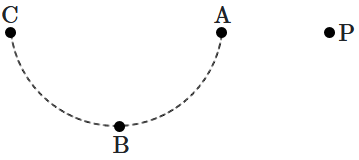
| 1. | zero | 2. | \(\dfrac{-q^2}{4\pi\varepsilon_0d}\) |
| 3. | \(\dfrac{-q^2}{4\pi\varepsilon_0d}\Big(3-\dfrac{1}{\sqrt2}\Big)\) | 4. | \(\dfrac{-q^2}{4\pi\varepsilon_0d}\Big(6-\dfrac{1}{\sqrt2}\Big)\) |
Consider the situation of the figure. The work done in taking a point charge from \(\mathrm{P}\) to \(\mathrm{A}\) is \(W_{\mathrm{A}}\) , from \(\mathrm{P}\) to \(\mathrm{B}\) is \(W_{\mathrm{B}}\) and from \(\mathrm{P}\) to \(\mathrm{C}\) is \(W_{\mathrm{C}}\). Then:
| 1. | \(W_{\mathrm{A}}<W_{\mathrm{B}}<W_{\mathrm{C}}\) | 2. | \(W_{\mathrm{A}}>W_{\mathrm{B}}>W_{\mathrm{C}}\) |
| 3. | \(W_{\mathrm{A}}=W_{\mathrm{B}}=W_{\mathrm{C}}\) | 4. | none of these |
| 1. | \(60\) ms–1 | 2. | \(75\) ms–1 |
| 3. | \(90\) ms–1 | 4. | \(100\) ms–1 |

| 1. | \(\Big(\dfrac{-qQ}{4\pi\varepsilon_0}\dfrac{1}{a}\Big)\sqrt {2}\) |
2. | \(\Big(\dfrac{qQ}{4\pi\varepsilon_0}\dfrac{1}{a}\Big)\sqrt{2}\) |
| 3. | \(\Big(\dfrac{qQ}{4\pi\varepsilon_0}\dfrac{1}{a}\Big)\dfrac{1}{\sqrt{2}}\) | 4. | zero |

| 1. | \(-\dfrac{q}{2 \pi^{} \varepsilon_{0} r^{}} \) | 2. | \(-\dfrac{q}{4 \pi^{} \varepsilon_{0} r^{}} \) |
| 3. | \(\dfrac{q}{4 \pi^{} \varepsilon_{0} r^{}} \) | 4. | \(0\) |
A neutral, isolated spherical copper particle of radius \(10~\text{nm}\) \((1~\text{nm}=10^{-9}~\text{m})\) is gradually charged by increasing the external voltage. The charging occurs slowly, such that electrons are added one at a time to the particle. Which of the following graphs correctly represents the variation of the total charge on the particle with the applied voltage?
| 1. |  |
2. |  |
| 3. |  |
4. |  |
| 1. | \(\dfrac{rV}{R^2}\) | 2. | \(\dfrac{R^2V}{r^3}\) |
| 3. | \(\dfrac{RV}{r^2}\) | 4. | \(\dfrac{V}{r}\) |
\(\Big(k=\dfrac{1}{4\pi\varepsilon_0}\Big)\)
| 1. | \(\dfrac{8~kq}{d}\) | 2. | \(\dfrac{4~kq}{d}\) |
| 3. | \(\dfrac{4\sqrt2~kq}{d}\) | 4. | \(\dfrac{\sqrt2~kq}{d}\) |
Two charged conducting spheres of radii \(a\) and \(b\) are connected to each other by a wire. The ratio of electric fields at the surfaces of the two spheres is:
| 1. | \(\dfrac{a}{b}\) | 2. | \(1\) |
| 3. | \(\dfrac{2a}{b}\) | 4. | \(\dfrac{b}{a}\) |
| 1. | dependent on the material property of the sphere |
| 2. | more on the bigger sphere |
| 3. | more on the smaller sphere |
| 4. | equal on both the spheres |







